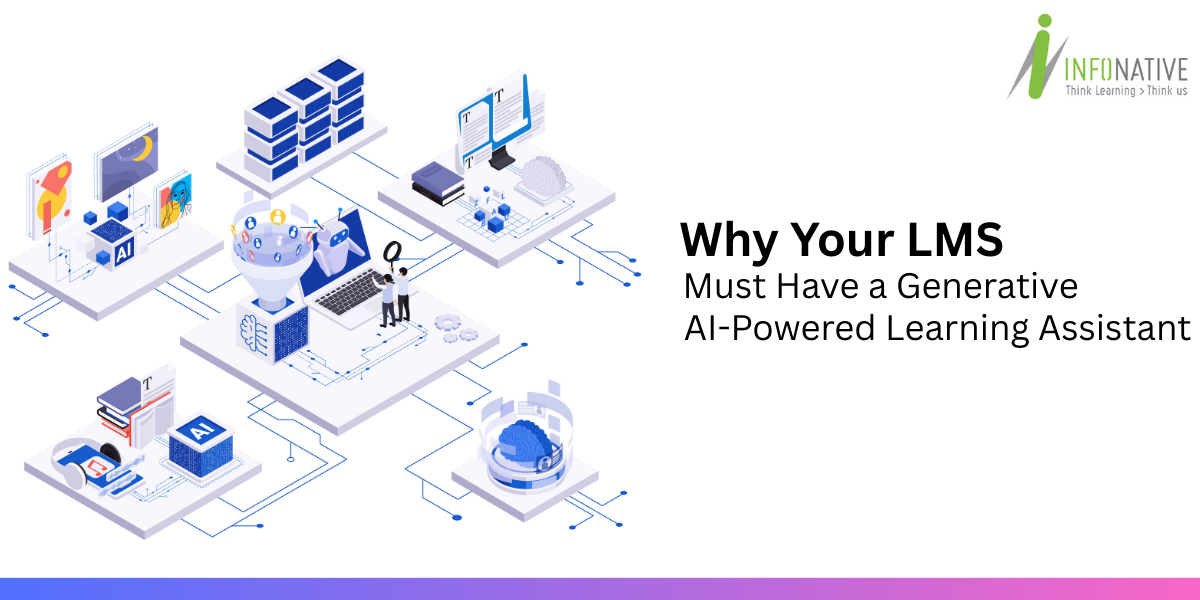Let’s be real — traditional LMS platforms are solid, but in today’s fast-paced world, just being "solid" isn’t enough. With learners craving personalization and institutions needing efficiency, there's a game-changer knocking at the door: Generative AI-Powered Learning Assistants.
These AI-driven sidekicks are transforming how we teach and learn. Whether you're managing a corporate training program or running an online course, integrating AI into your LMS isn't a "nice to have" — it's a must-have. Here’s why.
What is a Generative AI-Powered Learning Assistant?
At its core, a generative AI-powered learning assistant is an intelligent tool that uses advanced machine learning — especially natural language generation — to interact with learners like a human tutor would.
It goes beyond canned chatbot replies. Instead, it:
ㆍUnderstands user questions in real-time
ㆍGenerates context-aware, dynamic responses
ㆍProvides tailored explanations and feedback
ㆍEven creates new content like quizzes or summaries on demand
Think of it as the Siri or ChatGPT for your LMS — but with a Ph.D. in pedagogy.
Benefits of Integrating Generative AI into Your LMS
Personalized Learning Experiences
Imagine every learner having a private tutor who understands how they learn best. Generative AI can:
ㆍTrack learning progress
ㆍSpot weak spots
ㆍRecommend content that fits their style (visual, textual, interactive)
This isn’t just convenience — it’s the key to accelerated mastery.
Enhanced Engagement and Retention
Tired of dropouts or learners zoning out? AI can spice things up:
ㆍChat-based interactions make learning feel less like a lecture and more like a conversation
ㆍIt can quiz learners, tell stories, or crack jokes while explaining calculus
When learners are engaged, they remember — it’s that simple.
24/7 Availability for Learners
Office hours are so last decade. Generative AI doesn’t sleep:
ㆍIt’s always online to answer questions
ㆍLearners from any timezone can get help at 3 AM — no need to wait for emails or discussion board replies
Scalability for Educators and Institutions
AI doesn’t call in sick or get overwhelmed with grading:
ㆍIt can respond to thousands of learners simultaneously
ㆍIt drafts lesson plans, quizzes, feedback reports — freeing up educators to focus on what really matters: teaching
Key Features to Look for in an AI-Powered Learning Assistant
Natural Language Processing (NLP)
This technology empowers the assistant to interpret and respond to student input in a meaningful way. Whether a student is asking a question, expressing confusion, or showing signs of frustration, NLP allows the assistant to "understand" the context and intent behind the words, enabling more personalized and empathetic interactions.
Adaptive Learning Algorithms
Adaptive learning algorithms tailor their approach based on individual learner responses, much like a GPS. When a learner veers off course, the AI recalibrates the path, ensuring personalized guidance and continuous progress toward mastering the subject.
Integration with Existing LMS Platforms
Seamless integration with existing LMS platforms is essential. The ideal assistant connects effortlessly with Moodle, Canvas, Blackboard, and more—no need to rebuild or start over, ensuring a smooth transition and minimal disruption to your current systems.
Content Generation and Summarization
Whether you need a quiz, a concise summary, or a rephrased paragraph, AI delivers it instantly. Save time and boost productivity with smart tools that handle content creation and refinement in just seconds.
Use Cases in Different Learning Environments
Corporate Training
Speed up onboarding. Keep employees updated with real-time policy explanations or role-based training content.
K-12 Education
Help younger students with homework explanations, reading support, or interactive math drills.
Higher Education
Offer advanced subject tutoring, help with research methods, or guide thesis writing.
Self-Paced Learning Platforms
Make courses like coding bootcamps or language apps feel more interactive and supportive — even when learners go solo.
Challenges and Considerations
Data Privacy and Security
AI tools handle sensitive information. Ensure encryption, compliance with GDPR, FERPA, and transparency about data use.
Avoiding Bias in AI Responses
AI learns from data, which means it can pick up biases. Developers must audit and test regularly to keep things fair and neutral.
Maintaining Human Oversight
AI is a helper — not a replacement. Educators must remain involved to guide, mentor, and ensure accuracy.
Real-World Examples and Success Stories
ㆍArizona State University saw increased retention rates after integrating AI tutoring systems.
ㆍGoogle’s internal training uses AI to speed up employee skill acquisition.
ㆍDuolingo uses AI to adjust difficulty and give instant, personalized feedback — and it works.
The Future of AI in Learning Management Systems
We're just scratching the surface. Coming soon:
ㆍEmotion recognition (AI that knows when you’re frustrated)
ㆍVoice assistants integrated into e-learning
ㆍAI-created virtual learning environments (imagine a fully AI-driven Hogwarts)
If you're planning your LMS roadmap, AI isn't just the future — it's your next critical step.
Conclusion
Adding a generative AI-powered assistant to your LMS is like giving your learners a superpower. It personalizes the experience, breaks down barriers, and scales your impact — all while making learning more human.
If your LMS isn’t already on this train, now’s the time to hop on. Because the future of learning? It's not just digital — it's intelligent.




